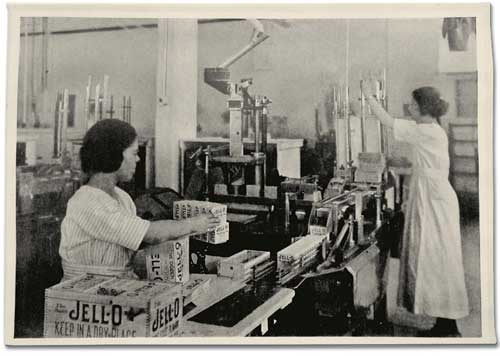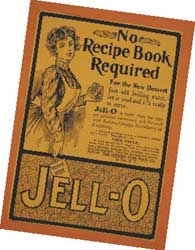|
|
|
 |
 |
 |
 |

Jello Museum
Jell-O: A Shimmering Slice of Americanan
By Robert Hirsch
From Forever Young Magazine, July 2005

Above: Assembly line workers at the former Jell-O packaging plant in LeRoy. |
Until the beginning of the twentieth century, the complexity and expense of preparing gelatine desserts meant they only appeared on the tables of royalty. This changed in 1897 when Pearle Wait of LeRoy, NY, developed a colorful gelatin dessert that his wife, May, named Jell-O. Lacking the resources to market his invention, Wait sold his product in 1899 for $450 to Orator Woodward’s Genesee Pure Food Company.
 Woodward promoted Jell-O in national magazines with slogans like: "No baking! Simply add boiling water and set to cool. Works like magic. No recipe book required." By 1903 Woodward had stylishly dressed salesmen in immaculate horse-drawn rigs distributing free recipe booklets to women door-to-door. In 1904 his company introduced the Jell-O Girl, symbolizing the ease in which it could be made. Sales of the 10¢-a-box product soared, making Jell-O a million dollar a year business by 1907. The evolution of Jell-O from a family-run operation to a corporate monolith is all too common in American business culture. A solitary inventor sells his idea to an established business, which becomes a subsidiary of General Foods Corporation that in turn gets gobbled up by Philip Morris, and is now part of Kraft/General Foods. This process of multinational corporate takeovers divested Jell-O from its own history when the LeRoy plant was closed in 1964 and operations moved to Dover Delaware. This phenomenon, now part of globalization, searches for short-term profits by draining human capital and creativity from an area, which is then abandoned in favor of cheaper locale where the process is repeated. Woodward promoted Jell-O in national magazines with slogans like: "No baking! Simply add boiling water and set to cool. Works like magic. No recipe book required." By 1903 Woodward had stylishly dressed salesmen in immaculate horse-drawn rigs distributing free recipe booklets to women door-to-door. In 1904 his company introduced the Jell-O Girl, symbolizing the ease in which it could be made. Sales of the 10¢-a-box product soared, making Jell-O a million dollar a year business by 1907. The evolution of Jell-O from a family-run operation to a corporate monolith is all too common in American business culture. A solitary inventor sells his idea to an established business, which becomes a subsidiary of General Foods Corporation that in turn gets gobbled up by Philip Morris, and is now part of Kraft/General Foods. This process of multinational corporate takeovers divested Jell-O from its own history when the LeRoy plant was closed in 1964 and operations moved to Dover Delaware. This phenomenon, now part of globalization, searches for short-term profits by draining human capital and creativity from an area, which is then abandoned in favor of cheaper locale where the process is repeated.
The Genesee Pure Food was a homegrown, paternalist, family-oriented company whose executives lived in LeRoy. Long-time employees felt the company looked out for them by providing living wage jobs, summer employment for kids, and even hiring a local orphan. While making sure Jell-O was served to Ellis Island detainees, it was the first company in the area to employ Italian immigrants.
The LeRoy Jell-O operation was basically a packaging plant. The gelatin was not manufactured in LeRoy; rather, ingredients were brought in, mixed, and put into boxes. At its peak the plant ran three shifts and employed 350 people with whistles regulating their daily lives. In a time before environmental legislation, the color of the local creek would reflect the flavor of Jell-O being produced that day.
Jell-O was made by women for women. The majority of the work force was women wearing nurse-like uniforms who operated printing and packaging machines with many commuting by train from Batavia, NY. According to Lynne Belluscio, Director of the LeRoy Historical Society, which operates the Jell-O Museum/Gallery and Historic LeRoy House. "Jell-O democratized gelatin. The company commissioned nationally known artists, including Rose O’Neill, Maxfield Parrish, and Norman Rockwell, to depict Jell-O as quick, easy, inexpensive, and sure to please, which we used in national advertising campaigns."
Jewish (Jack Benny) and African American (Bill Cosby) comedians were employed as spokesmen to market the quintessential, American nature of Jell-O: brash, bright, sweet, unpretentious, and highly adaptable. Dawn Ireland-Monsees, Museum Group Tour Coordinator, observes, "Jell-O represents many things to different people. Everyone has a Jell-O story or memory and our museum provides a storybook for visitors to record their favorite Jell-O tales."
Jell-O’s success is part of the American tradition of the wealthy buying the same goods as everyone else. Ads showed Jell-O served by butlers and housewives. Jell-O is always Jell-O. Whether it is served at President Clinton’s White House Thanksgiving dinner or at your neighbor’s kitchen table, no amount of money is going to buy you a better package of Jell-O.
Numerous advertisements, artifacts, paintings, photographs and recipes are on view at The Jell-O Gallery & Gift Shop, 23 E. Main Street, LeRoy, NY; 585-768-7433. Hours are: Monday - Saturday 10 a.m. - 4 p.m., Sunday 1 - 4 p.m., May 1 to Nov. 1, 2005. Weekdays only from November to April. Admission is $3 Adults, $1.50 Kids. For more information visit: www.jellomuseum.com.
|
|
 |
 |
 |
 |
|
|
|